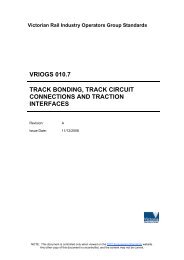VRIOGS 002.1 Railway Station Design Standard and Guidelines
VRIOGS 002.1 Railway Station Design Standard and Guidelines
VRIOGS 002.1 Railway Station Design Standard and Guidelines
Create successful ePaper yourself
Turn your PDF publications into a flip-book with our unique Google optimized e-Paper software.
<strong>VRIOGS</strong> <strong>002.1</strong> Revision A 134.7 HERITAGE CONSIDERATIONSHeritage Victoria is the Victorian Governments principal cultural (non-indigenous) heritageagency <strong>and</strong> is part of the Department of Planning <strong>and</strong> Community development. HeritageVictoria administers the Heritage Act 1995 <strong>and</strong> maintains the Victorian Heritage Register.Subject to the criteria set out for the classification of a heritage railway station buildingunder the Heritage Act, any work, improvement, alteration, sale or demolition of aclassified station must have the approval of the Heritage manager <strong>and</strong> the HeritageManagement Committee before the work commences.The appropriate Heritage Victoria procedures for maintenance <strong>and</strong> permissible alterationsto Heritage Classified railways stations <strong>and</strong> their environment must be carried out inaccordance with the guidelines set out by Heritage Victoria.It is important to establish an underst<strong>and</strong>ing of how a Heritage place can be used bypeople with disabilities. There should be a consultative process carried out with all relevantdisability groups, Heritage Victoria, Transport Operators <strong>and</strong> the Accessibility unit of DOT.There are also locally significant heritage railway stations which are governed by localCouncil’s planning requirements. Check with the council planning department to confirmany restrictions <strong>and</strong> obtain a planning permit during the design stage shall be undertaken.4.8 ENVIRONMENTAL SUSTAINABILITYThe station building shall include environmental design elements that include but are notlimited to:i. Use of energy efficient fittings i.e. energy efficient lighting;ii. Orientation to gain benefits from natural light <strong>and</strong> heating;iii. Collection of rainwater <strong>and</strong>/or grey water that will be treated on site stored intanks <strong>and</strong> may be used for toilet flushing, station cleaning <strong>and</strong> l<strong>and</strong>scapepurposesa) Environment <strong>Design</strong>Better building environments offer healthier, more liveable spaces that save resources <strong>and</strong>impact less on the surrounding environments. New station designs shall promote theprinciples of environmental design that address:i. Energy efficiency through passive design principles;ii.iii.iv.Reduced operational energy dem<strong>and</strong> by utilising natural lighting <strong>and</strong> ventilation;Application of renewable energy sources;Environmentally friendly products which conserve natural resources;v. Reduce toxicity <strong>and</strong> minimise carbon footprint over its life cycle;vi.vii.viii.ix.Recycling <strong>and</strong> waste management;Water conservation <strong>and</strong> harvesting, including the collection of stormwater forstation re-use;Ecological construction <strong>and</strong> maintenance methods;Maintaining biodiversity within the existing environment.NOTE: This document is controlled only when viewed on the DOT Engineering <strong>St<strong>and</strong>ard</strong>s website. Any othercopy of this document is uncontrolled, <strong>and</strong> the content may be inaccurate.

















